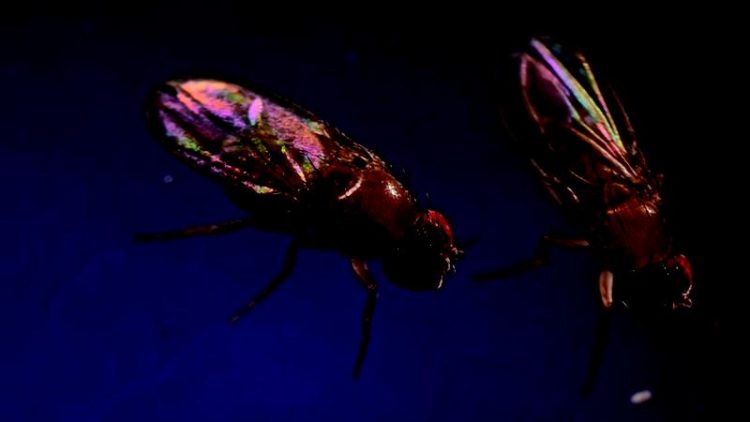DNA with self-interest – Transposable element conquers new strain of fly

The P-Element is present in D. melanogaster for more than 60 years. It recently also invaded D. simulans. Photo: Markus Riedl/Vetmeduni Vienna
Scientists from the Vetmeduni Vienna found that one of the most important transposable elements, the P-element, has only recently invaded the fly Drosophila simulans.
The P-element has been present in the closely related species Drosophila melanogaster since the 1950s. The latest findings offer a unique opportunity to study the spread of transposable elements. The results were published in the journal PNAS.
Transposable elements are DNA sequences that are capable of changing their genome position by cut and paste or copy and paste through the enzyme transposase. This ability can be harmful for hosts if transposable elements destroy functioning genes, but it can also bring advantages. From an evolutionary point of view, transposable elements diversify the genome and open up chances for adaptation.
DNA that uses its host
Transposable elements are also called selfish DNA parasites because they spread through their hosts, such as humans, animals, plants as well as bacteria and, thus, provide for their own survival.
Robert Kofler from the Institute of Population Genetics at the Vetmeduni Vienna analysed flies from all over the world. He discovered a phenomenon which was thought to be very rare. Kofler found a transposable element in the fly species Drosophila simulans, the so-called P-element. This transposable element has been absent in D. simulans until recent years.
“The P-element has been spreading rapidly in D. simulans within the past five years. It probably invaded the species via horizontal gene transfer. When exactly the transfer happened, is not clear”, says lead author Kofler.
The DNA sequence was not inherited but directly transferred from one organism to another. “This happened to Drosophila melanogaster more than 60 years ago. The P-element was discovered twice in a new species within one hundred years. Therefore we can assume that transposable elements are transferred across the species faster than we thought.”
A transposable element conquers the world
Although scientists found the P-element in D. simulans flies from South Africa as well as from the USA, they assume that there was only one single transfer event. On average, the South African flies had more P-elements in their genome than flies from Florida. “This indicates that the flies from Florida, collected in 2010, were in an early stage after the transfer event. The samples from South Africa are from 2012. The P-element significantly multiplied within these two years”, Kofler concludes.
High-speed evolution in the lab
Head of the institute, Christian Schlötterer, and his team perform high-speed evolution in the lab. They expose fruit flies to extreme conditions such as heat, cold or UV radiation. Before and after the exposure, they sequence the flies’ genomes. The evolve-and-resequence approach makes it possible to identify genes that have been selected through generations. The researchers now want to study the spread of the P-element under such conditions.
“The discovery of the P-element in Drosophila simulans offers the unique possibility to investigate the way transposable elements are regulated and how they survive. We can accelerate evolution in the lab and, thus, answer this and other questions”, Schlötterer explains.
Service:
The article „ The recent invasion of Drosophila simulans by the P-element”, by Robert Kofler, Tom Hill, Viola Nolte, Andrea Betancourt, and Christian Schlötterer was published in the journal PNAS. doi: http://dx.doi.org/10.1101/013722
About the University of Veterinary Medicine, Vienna
The University of Veterinary Medicine, Vienna in Austria is one of the leading academic and research institutions in the field of Veterinary Sciences in Europe. About 1,300 employees and 2,300 students work on the campus in the north of Vienna which also houses five university clinics and various research sites. Outside of Vienna the university operates Teaching and Research Farms. http://www.vetmeduni.ac.at
Scientific Contact:
Dr. Robert Kofler
Institute of Population Genetics
University of Veterinary Medicine Vienna (Vetmeduni Vienna)
T +43 1 25077-4337
rokofler@gmail.com
Released by:
Susanna Kautschitsch
Science Communication / Public Relations
University of Veterinary Medicine Vienna (Vetmeduni Vienna)
T +43 1 25077-1153
susanna.kautschitsch@vetmeduni.ac.at
http://www.vetmeduni.ac.at/en/infoservice/presseinformation/press-releases-2015/…
Media Contact
All latest news from the category: Life Sciences and Chemistry
Articles and reports from the Life Sciences and chemistry area deal with applied and basic research into modern biology, chemistry and human medicine.
Valuable information can be found on a range of life sciences fields including bacteriology, biochemistry, bionics, bioinformatics, biophysics, biotechnology, genetics, geobotany, human biology, marine biology, microbiology, molecular biology, cellular biology, zoology, bioinorganic chemistry, microchemistry and environmental chemistry.
Newest articles

NASA: Mystery of life’s handedness deepens
The mystery of why life uses molecules with specific orientations has deepened with a NASA-funded discovery that RNA — a key molecule thought to have potentially held the instructions for…

What are the effects of historic lithium mining on water quality?
Study reveals low levels of common contaminants but high levels of other elements in waters associated with an abandoned lithium mine. Lithium ore and mining waste from a historic lithium…

Quantum-inspired design boosts efficiency of heat-to-electricity conversion
Rice engineers take unconventional route to improving thermophotovoltaic systems. Researchers at Rice University have found a new way to improve a key element of thermophotovoltaic (TPV) systems, which convert heat…



